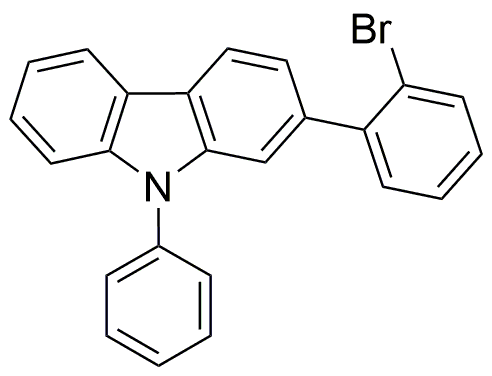2-(2-Bromophenyl)-9-phenyl-9H-carbazole is widely utilized in research focused on:
- Organic Electronics: This compound is used in the development of organic light-emitting diodes (OLEDs), enhancing display technologies in smartphones and televisions due to its excellent light-emitting properties.
- Photovoltaic Cells: It plays a significant role in organic solar cells, improving energy conversion efficiency and offering a lightweight alternative to traditional silicon-based cells.
- Fluorescent Sensors: The chemical is employed in creating fluorescent sensors for detecting environmental pollutants, providing a sensitive and cost-effective method for monitoring air and water quality.
- Pharmaceutical Research: It serves as a building block in drug discovery, particularly in developing compounds with potential anti-cancer properties, thus contributing to advancements in cancer treatment.
- Polymer Chemistry: This compound is utilized in synthesizing advanced polymers with tailored properties, which can be applied in various industries, including automotive and aerospace, for lightweight and durable materials.
General Information
Properties
Safety and Regulations
Applications
2-(2-Bromophenyl)-9-phenyl-9H-carbazole is widely utilized in research focused on:
- Organic Electronics: This compound is used in the development of organic light-emitting diodes (OLEDs), enhancing display technologies in smartphones and televisions due to its excellent light-emitting properties.
- Photovoltaic Cells: It plays a significant role in organic solar cells, improving energy conversion efficiency and offering a lightweight alternative to traditional silicon-based cells.
- Fluorescent Sensors: The chemical is employed in creating fluorescent sensors for detecting environmental pollutants, providing a sensitive and cost-effective method for monitoring air and water quality.
- Pharmaceutical Research: It serves as a building block in drug discovery, particularly in developing compounds with potential anti-cancer properties, thus contributing to advancements in cancer treatment.
- Polymer Chemistry: This compound is utilized in synthesizing advanced polymers with tailored properties, which can be applied in various industries, including automotive and aerospace, for lightweight and durable materials.
Documents
Safety Data Sheets (SDS)
The SDS provides comprehensive safety information on handling, storage, and disposal of the product.
Product Specification (PS)
The PS provides a comprehensive breakdown of the product’s properties, including chemical composition, physical state, purity, and storage requirements. It also details acceptable quality ranges and the product's intended applications.
Certificates of Analysis (COA)
Search for Certificates of Analysis (COA) by entering the products Lot Number. Lot and Batch Numbers can be found on a product’s label following the words ‘Lot’ or ‘Batch’.
Numéro de catalogue
Numéro de lot/série
Certificates Of Origin (COO)
This COO confirms the country where the product was manufactured, and also details the materials and components used in it and whether it is derived from natural, synthetic, or other specific sources. This certificate may be required for customs, trade, and regulatory compliance.
Numéro de catalogue
Numéro de lot/série
Safety Data Sheets (SDS)
The SDS provides comprehensive safety information on handling, storage, and disposal of the product.
DownloadProduct Specification (PS)
The PS provides a comprehensive breakdown of the product’s properties, including chemical composition, physical state, purity, and storage requirements. It also details acceptable quality ranges and the product's intended applications.
DownloadCertificates of Analysis (COA)
Search for Certificates of Analysis (COA) by entering the products Lot Number. Lot and Batch Numbers can be found on a product’s label following the words ‘Lot’ or ‘Batch’.
Numéro de catalogue
Numéro de lot/série
Certificates Of Origin (COO)
This COO confirms the country where the product was manufactured, and also details the materials and components used in it and whether it is derived from natural, synthetic, or other specific sources. This certificate may be required for customs, trade, and regulatory compliance.


